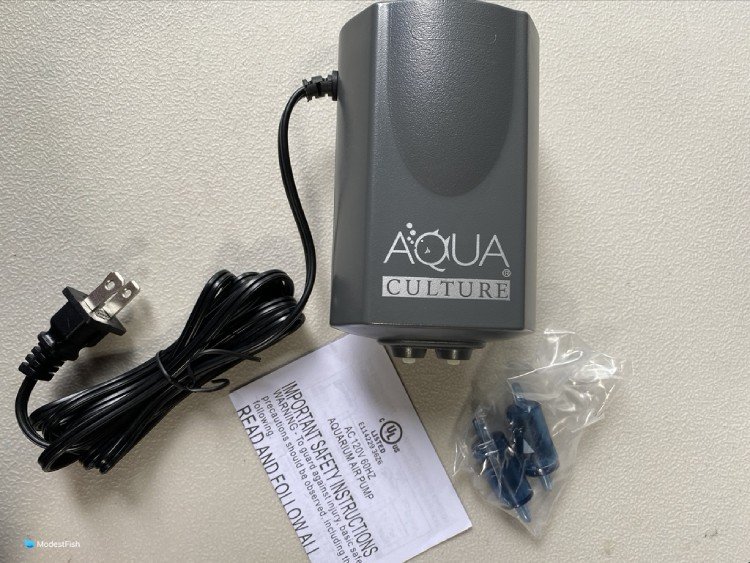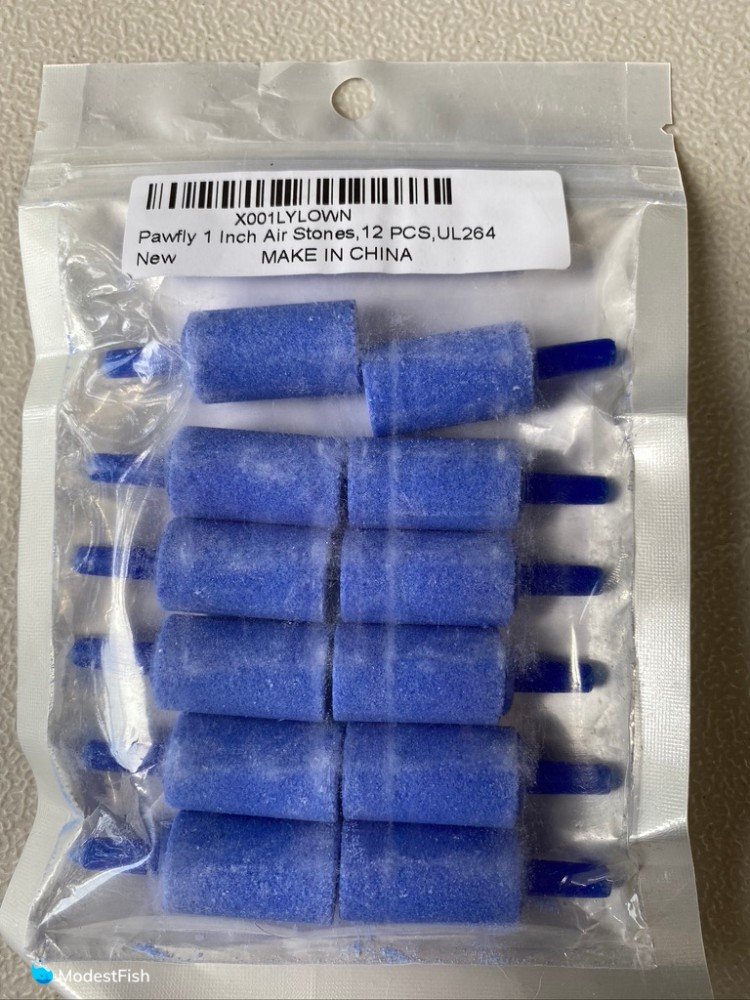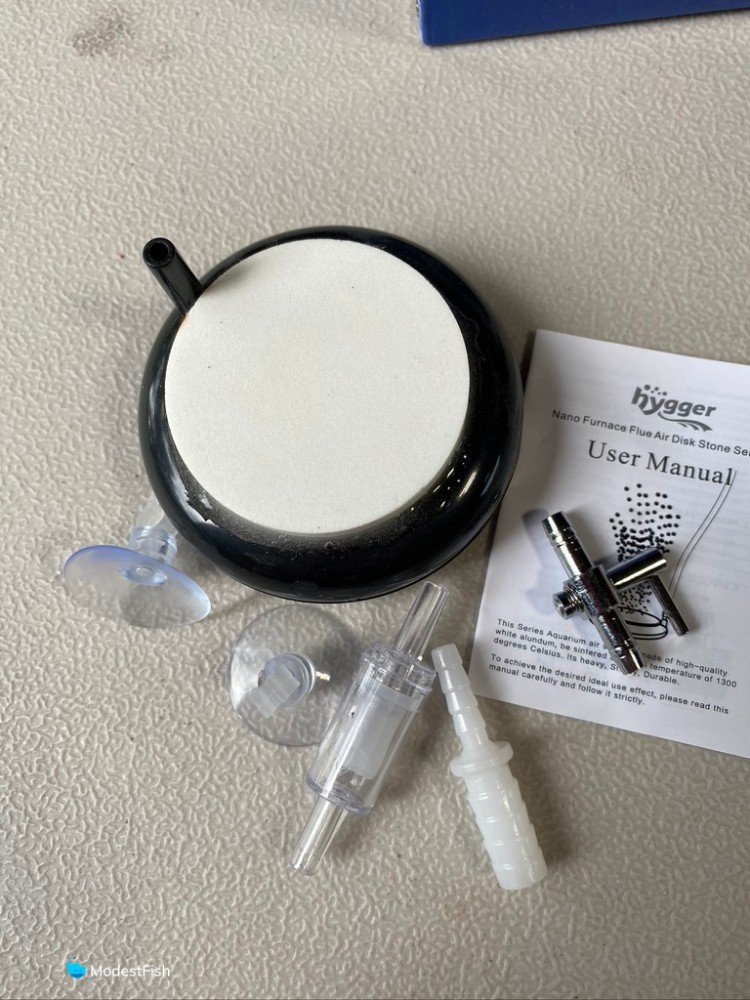Using an air pump with your aquarium is a great way to increase flow and oxygen levels in your water.
But, you’ve got to make sure that you use the pump correctly. Incorrect use can not only break your pump, it could be a safety concern.
Have no fear! Today, I’m happy to go over how to properly use an air pump with your aquarium.
Just to ensure everyone stays safe, I want to make sure to point out right away that air pumps are not submersible at all. They are meant to be set up outside the aquarium and the air is pumped through tubing into the tank. Do not ever put an aquarium air pump in water!
Choosing the Right Pump for Your Tank
Not all air pumps are created equal. The deeper your tank is, the stronger your pump needs to be to overcome the water pressure.
Pressure increases with depth, even with something as small as an aquarium. If a pump is too small for a tank, it may not be strong enough to push air at the depth that you need.
Conversely, if you use a pump that is too strong for a small tank, you could be blasting way too much air into the aquarium.
Make sure to look at what size tank a pump is rated for before you purchase it.
Please, see our in-depth article comparing different air pumps, here.
How to Set up and Use an Air Pump

Stuff You Need
You’ll need a few other pieces of equipment and supplies to safely and effectively use your air pump.
Airline
Airline is flexible vinyl tubing that connects to the air outflow nipple(s) on your pump so that air can be pushed through the tubing into the aquarium.
It comes in a variety of colors: green, black, blue and clear.
I personally always use clear. I’ve never found that the other colors help to hide the tubing at all, and my favorite kind only comes in clear. But, to each their own.
I like this AquaNeat tubing. It’s soft, flexible and really easy to attach to pumps and airstones. Some airline tubing stiffens up over time, but this AquaNeat airline stays flexible.
I’ve been using it for several years now, I’ve re-ordered it many times, and I’m rather impressed with it.

Last update on 2024-04-26 / Commissions Earned / Images from Amazon Product Advertising API
Airstone/Diffuser


It’s important to use some sort of airstone or diffuser at the end of the airline that goes in the tank.
If you just stick the end of the airline in the water with no diffuser, it will just float at the surface, putting out great big bubbles that will make a bunch of noise. This would be really ineffective for creating water flow and aerating the tank.
An airstone will break the large bubbles into a stream of much finer bubbles. A stream of fine bubbles creates much more lift, does a better job of breaking the tension of the water’s surface, and therefore, is much more efficient at aerating the water column.
Also, breaking up the big bubbles makes the stream much quieter, eliminating the loud “blub, blub” noise that comes from large bubbles at the surface.
Please, see our article comparing different kinds of airstones, here.
Check Valve
I consider check valves to be absolutely essential when using an aquarium air pump.
A check valve is a little plastic cylinder that you splice onto your airline close to where it emerges from the aquarium. Each end of the cylinder has a little nipple, you just cut the airline and each cut end fits onto the little nipples on the check valve.
The valve will let air flow towards the tank, but will not let water backflow into your pump if the power gets cut.
When an air pump cuts off suddenly, the loss of pressure creates a vacuum that then siphons water through the airline, towards the pump. If the water gets inside the air pump, the pump will likely be ruined. Not to mention, you also then have water inside an electrical device when the power comes on, causing a possible safety hazard.
I can say from experience that I lost three air pumps this way when I was a novice. Now, I use check valves on ALL of my pumps so that I don’t lose valuable equipment.
And the nice thing is, check valves are super cheap. You can get a whole bag for a pretty low price. Plus, they only take about 2 minutes to install.
I’ve been using these BornFeel brand valves for over a year and they’ve been great.

Last update on 2024-04-26 / Commissions Earned / Images from Amazon Product Advertising API
Airline Holders
A lot of times, airstones want to float to the surface of the water while in use.
Some airstones are weighted, or come with their own suction cups to keep them in place. But for ones that don’t, I recommend using some airline holders so you can secure the tubing and keep it from floating around in the tank.
The holders are just little suction cups with tiny brackets on the back that clip onto the airline.
My one thing about these, though, is that the suction cups do wear out over time. But, luckily, the holders are really cheap, you get a big bag of them for a pretty low cost.
So, you can just replace them if they stop sticking.

Last update on 2024-04-25 / Commissions Earned / Images from Amazon Product Advertising API
How to Set Up an Aquarium Air Pump
- Determine where your pump is going to sit. You can’t figure out how much airline you’ll need until you know exactly where your pump will be.
- Attach one end of your airline to the pump, but keep the pump unplugged from power for now. Unwind your airline and run it from the pump to where you want to place your airstone. I highly recommend leaving some extra slack. You don’t want tension on the airline.
- Attach your airstone or diffuser to the end of the airline and place it in the tank. Remember, many airstones tend to float once the air is turned on, so you may need to use some airline holders to keep everything in place.
- Cut the airline about 12 inches (30 centimeters) from where it emerges from the tank. Install a check valve in between the two cut ends. Make sure to orient the valve properly, there’s usually a little arrow printed on the side. The arrow should point towards the aquarium. Air will be able to flow in the direction the arrow is pointing, but water will be prevented from flowing back towards the pump.
- Once you’ve got everything in place, plug in your pump to power and enjoy!
Final Thoughts
Air pumps are a great addition to most aquariums. The bubbles create lift and break the surface tension of the water, which in turn helps to aerate the aquarium.
Extra flow and oxygenation is great for fish and invertebrates. And air pumps can help eliminate “dead zones” in the tank that have no water movement.
As a bonus, I think the stream of bubbles adds on an interesting visual element that’s nice to look at.
Setting up an aquarium air pump isn’t hard, but it’s important to do it properly to ensure the pump doesn’t get ruined in the event of a power failure.
I hope you find this article helpful.
I wish you and your fish the very best!
